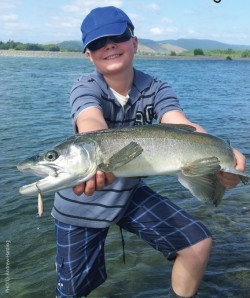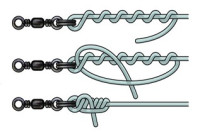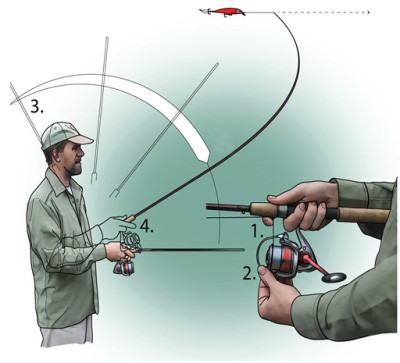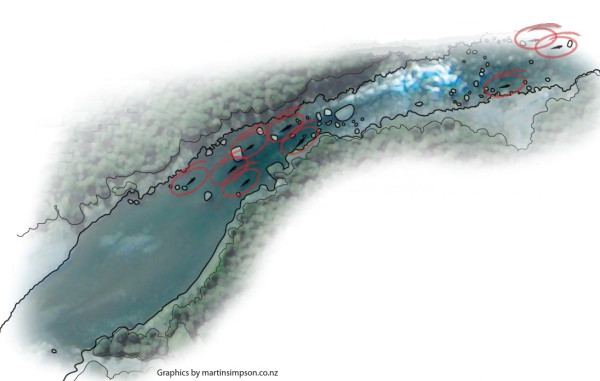Spin fishing is a great way to start trout fishing as the skills are easily mastered.
 Spin fishing is a great way to start trout fishing as the skills are easily mastered.
Spin fishing is a great way to start trout fishing as the skills are easily mastered.
A basic outfit of rod, reel and line, plus a few lures are all you need to have a good chance of catching trout.
The watercraft and knowledge of trout habits learned while spin fishing are just as useful for other trout fishing methods such as fly fishing.
Spin fishing is fishing for trout with lures that imitate small fish. They are cast with an outfit consisting of an 'egg beater' reel loaded with suitable monofilament line, and a short, single-handed spinning rod.
There are lots of spin fishing tips in our introduction to trout fishing videos.
Click here for part one on gear, and here for part two on fishing 'basics.'
If you want to try fly fishing, click here for information.
If you plan to boat fish, here are some pointers.
You can also download our 'Spin Fishing How-to Guide' brochure (information shown below) here.
There is also our 'Advanced Spin Fishing How-to Guide, select here to view.
Getting started – the beauty of spinning
The beauty of spinning lies in its simplicity - it’s a method which requires little in the way of equipment, doesn’t demand great experience or technique, but offers an effective means of getting started in the wonderful pursuit of angling for freshwater sports fish.
Spinning can also be a highly productive method which opens up more water and more fishing opportunities, even for experienced anglers. Often, when the right conditions prevail, it will out-fish other techniques.
This resource has been put together primarily as an introductory guide for those new to the sport, however it will also provide useful tips and advice on the latest techniques to help proficient anglers catch more fish.
It focusses on spin fishing in rivers, but similar principles also apply to still water such as lakes or estuaries.
What gear do I need?
Rods
There is a large range of spinning rods on the market - be sure to let the staff at you local tackle store know that you require it for freshwater spin fishing, so you don’t inadvertently end up with a saltwater ‘spinning’ outfit designed for softbait fishing.
Ideally the rod needs to be between 6’6” and 7’ long, and preferably of graphite construction. Graphite rods help achieve better hook-set than soft fibreglass rods, but it is also lighter and therefore far less demanding when casting all day long.
Look for a rod with a minimum of six guides - these will distribute the line evenly when playing a fish, enabling better control and less chance of line wear. Some rods come in multiple pieces and these are excellent for packing into backcountry areas.
Reels
Spinning reels are generally considered far easier to master than other reel designs. The recommended line weight marked on the reel should be matched to the rod line weight, and ideally the lighter the better. It is important that your drag is set at the correct pressure - you should be able to pull line off steadily without any slipping. Don’t have the drag so tight that it cuts into your hand when testing the tension, and nor should it be so loose that there is barely any tension at all.
Line
For the main line, either braid or nylon can be used. Braid line between 3-6lbs will help with hook-set and increase casting distance dramatically. Note that braid is typically twice as strong as its rated breaking strain, so do not worry if the ultra thin line looks somewhat flimsy!
Because there is quite a lot of stretch in nylon, braid is increasingly becoming the preferred option today. If opting for nylon, remember that the heavier it is, the less distance you will cast – anything over 6lbs is too heavy.
Knots and spooling tips
If using nylon main line, you can tie the line directly to your lure.
For braid main line, a nylon leader (a length of line between the lure and the main line ) of 3-4m should be attached so the fish has less chance of spotting the braid.
A Double Uni Knot is best for joining a light leader to light braid (you’ll find a demonstration on YouTube).
When putting the line on your reel (spooling) with either line, ensure it is wound on tightly as loose winding will cause loops and tangles. If in doubt, ask the staff at your local tackle shop to spool it for you.

What lures work best and where
There is a huge range of lures available on the market, and it’s best to have a variety to suit different conditions.
By far the best lures on the market today are the bibbed, Rapala-type designs which have a plastic ‘lip’ at the front to help it swim deeper. Natural ‘Trout’ patterns or those which imitate bullies or whitebait (in season) produce great results.
Other great lure choices are Kilwell Daffy’s, Phils Favourites in 7 gram, Kilwell Gypsy’s and Mepps/Veltics bladed spinners. Some regions also permit the use of scented soft plastics where bait fishing is allowed, which can be very effective, but first check your local regulations.
Look for lures that have a weight range between 5 to 10 grams - this is, however, dependant on the depth of water you are fishing. If you are fishing deeper water, change to a heavier lure etc.
Our rivers have an abundance of bullies and trout fry, so think like a trout and try to mimic the colouration and pattern of these prey items. Whatever lure you choose, consider the impact on the fish if you plan to release it. Replacing trebble hooks with single hooks is a great idea as it minimises damage to the fish and mostly results in no difference to the hook-up rate.
Adding a small snap swivel to your line, can help with quick lure changes and reduce line twist if using bladed lures.
Casting
Ensure that your rod sections are tight and secure (waxed) - there’s nothing worse than sending out a cast only to see a section of the rod chase after the lure.
- Trap the line with your index finger.
- With you other hand open the reel’s bail arm.
- Slowly swing the rod back.
- Accelerate the rod forward smoothly toward the target area - use more wrist than arm - and release the line when the rod reaches the position illustrated below.

How to catch fish on a spinner
With spinning you can work either upstream or downstream.
With bibbed lures it’s best to position yourself at the top of the run or pool, cast directly across and allow your lure to gently swing through the current while retrieving. Always follow the lure downstream with your rod tip low. Let the current work the lure’s action or movement.
When fishing upstream, ensure you retrieve just slightly faster than the current moving towards you so there is enough speed to impart action in the lure.
In both instances, the lure should generally move at the same pace as a real fish. Cast beyond the place you expect fish to be and retrieve through this ‘strike zone’. This is where accuracy and practice pays off.
Finding fish
Hot spots are undercut banks and shaded areas, in front of or behind structure such as large boulders, submerged logs or sections of river bank that jut out into the river.
Also, the fast white-water at the heads of pools will yield results, or target sections of the river where there is a noticeable change in water flow - often trout will hold on the edge of slow moving water, ready to dart into the fast current to snatch food items or flee from threats. If the river is coloured from higher than normal flow, look towards the tails and mid sections of pools.
The diagram below shows prime trout lies and positions.

The lower reaches or confluences of side streams and tributaries that enter a main river are also great spots to locate fish - this is particularly the case during higher flows. If the water you are fishing is deep, take your time, work the lure slowly and vary the retrieve speed - you are trying to mimic a wounded or fleeing fish, a straight retrieve often does not work as well as an erratic one.
When fishing lakes, look for inflowing streams (where spinning is permitted), structure (such as logs, prominent shelves or headlands jutting out into the water, weed beds), and drop offs where there is marked change in lake depth.
Again, your lure should be fished as close to the bottom as possible - real baitfish seldom swim midway or high up in the water column.